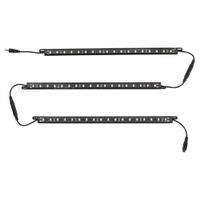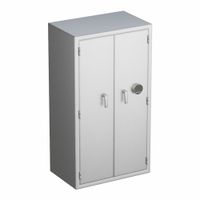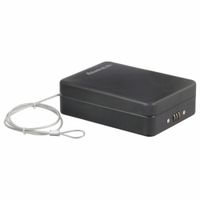Call +(254) 703 030 000 / 751 483 999 / 721 704 777
.....Read More
Frequently Asked Questions
What is the best type of safe for home use?
The best type of safe for home use depends on individual needs, but generally, a fireproof and waterproof safe with a combination of security features is ideal. Look for safes that are UL-rated for fire resistance, typically offering at least 30 minutes of protection at 1,550 degrees Fahrenheit. This ensures that important documents and valuables are protected in case of a fire. Additionally, a waterproof safe is crucial to protect contents from water damage due to flooding or firefighting efforts.
For security, a safe with a solid steel construction and a reliable locking mechanism is essential. Biometric safes, which use fingerprint recognition, offer quick access and high security. Alternatively, electronic keypad safes provide convenience and ease of use, while traditional combination locks are known for their reliability.
Consider the size and weight of the safe. A heavier safe is more difficult for thieves to remove, but ensure it fits in the intended space. Wall or floor safes offer added security by being concealed, while portable safes provide flexibility for those who may need to move them.
Anchor the safe to the floor or wall to prevent theft. Look for models with pre-drilled holes for easy installation. Additionally, consider a safe with an interior light and adjustable shelves for better organization and visibility.
Ultimately, the best home safe balances fire and water protection with robust security features, tailored to the specific needs and budget of the homeowner.
How do I choose the right size safe for my needs?
To choose the right size safe, first assess what you intend to store. List items like documents, jewelry, electronics, firearms, or cash. Measure larger items to ensure they fit. Consider future needs; it's wise to choose a slightly larger safe than currently necessary to accommodate future acquisitions.
Next, determine the safe's location. Measure the intended space, ensuring the safe fits and can be easily accessed. Consider weight, especially for upper floors, and ensure the floor can support it. For wall or floor safes, ensure there's enough depth.
Evaluate the safe's security features. Safes are rated by their ability to withstand fire, water, and theft. Fire ratings indicate how long a safe can protect its contents at certain temperatures. Water resistance is crucial for flood-prone areas. Theft protection is measured by the safe's construction and locking mechanism. Choose a safe with a rating that matches your security needs.
Consider the safe's locking mechanism. Options include key locks, combination dials, electronic keypads, and biometric locks. Choose one that balances security with ease of access.
Budget is also a factor. Larger safes with advanced features cost more. Balance your needs with what you can afford.
Finally, think about insurance requirements. Some insurers have specific requirements for safes to cover high-value items.
In summary, choose a safe based on the size and type of items you need to store, the space available, security features, locking mechanism, budget, and insurance requirements. Opt for a slightly larger safe to accommodate future needs.
What are the differences between fireproof and waterproof safes?
Fireproof safes and waterproof safes are designed to protect their contents from different types of threats, and they have distinct features to serve these purposes.
Fireproof Safes:
1. **Purpose**: Designed to protect contents from high temperatures and flames.
2. **Construction**: Made with materials like gypsum or concrete composites that insulate against heat.
3. **Temperature Resistance**: Rated to withstand specific temperatures (e.g., 1,550°F) for a certain period (e.g., 30 minutes to 2 hours).
4. **Seal**: Often have a heat-activated seal that expands to protect contents from smoke and heat.
5. **Contents**: Ideal for documents, paper, and digital media that can be damaged by heat.
6. **Testing Standards**: Typically tested by standards like UL (Underwriters Laboratories) or ETL for fire resistance.
Waterproof Safes:
1. **Purpose**: Designed to protect contents from water damage due to flooding, leaks, or submersion.
2. **Construction**: Built with watertight seals and materials that prevent water ingress.
3. **Water Resistance**: Rated for submersion or water exposure for a specific duration (e.g., 24 hours).
4. **Seal**: Equipped with gaskets or seals that prevent water from entering.
5. **Contents**: Suitable for protecting items like documents, electronics, and valuables from water damage.
6. **Testing Standards**: Often tested for water resistance by standards like ETL.
Combination Safes:
1. **Dual Protection**: Some safes offer both fireproof and waterproof features, providing comprehensive protection.
2. **Versatility**: Ideal for environments prone to both fire and water risks.
In summary, fireproof safes focus on heat protection, while waterproof safes guard against water damage. Combination safes offer both types of protection, catering to a broader range of threats.
How do I properly install a safe in my home or business?
1. **Choose Location**: Select a discreet, secure spot away from windows and high-traffic areas. Consider the floor type and proximity to structural support.
2. **Select Safe Type**: Decide between a wall, floor, or standalone safe based on your security needs and space availability.
3. **Gather Tools**: You’ll need a drill, appropriate drill bits, a level, a measuring tape, and mounting bolts or anchors.
4. **Prepare the Area**: Clear the installation area. For wall safes, ensure there are no electrical wires or plumbing behind the wall.
5. **Mark the Spot**: Use the safe’s template or back panel to mark drilling spots on the wall or floor. Ensure the markings are level.
6. **Drill Holes**: Use a drill to create holes for the mounting bolts. For concrete floors, use a masonry bit.
7. **Install Anchors**: Insert wall or floor anchors if required, ensuring they are flush with the surface.
8. **Position the Safe**: Place the safe over the drilled holes. Use a level to ensure it is perfectly aligned.
9. **Secure the Safe**: Insert and tighten the mounting bolts through the safe into the anchors or directly into the wall/floor. Ensure the safe is firmly attached and does not wobble.
10. **Test the Safe**: Open and close the safe to ensure the door operates smoothly. Check the locking mechanism.
11. **Conceal the Safe**: Use furniture or decor to hide the safe from plain view, enhancing security.
12. **Maintain Access**: Keep the combination or key in a secure, memorable place. Consider a backup access method.
13. **Regular Checks**: Periodically check the safe’s stability and locking mechanism to ensure continued security.
What are the most secure locking mechanisms for safes?
The most secure locking mechanisms for safes include:
1. **Biometric Locks**: These use unique biological traits such as fingerprints, retinal scans, or voice recognition. They offer high security as they are difficult to replicate or bypass.
2. **Electronic Keypad Locks**: These require a numerical code to unlock. They are convenient and can be reprogrammed easily, offering flexibility and security. Advanced models may include features like time delay or duress codes.
3. **Dual-Locking Mechanisms**: These combine two different types of locks, such as a combination lock with a key lock or an electronic lock with a biometric lock. This adds an extra layer of security, requiring two methods to unlock the safe.
4. **Mechanical Combination Locks**: Traditional and reliable, these locks use a rotating dial to enter a combination. They are not susceptible to electronic hacking and do not require batteries, making them dependable over time.
5. **Time Locks**: Often used in bank vaults, these locks can only be opened at certain times. They are typically used in conjunction with other locking mechanisms to enhance security.
6. **Smart Locks**: These can be controlled via smartphone apps and may include features like remote access, audit trails, and alerts. They offer convenience and advanced security features, though they may be vulnerable to cyber threats.
7. **Key Locks**: While not the most secure on their own, high-security key locks with complex keyways and restricted key duplication can provide a good level of security, especially when used in combination with other locks.
Each of these mechanisms has its strengths and potential vulnerabilities, and the choice depends on the specific security needs and context of use.
How do I reset the combination on my safe?
To reset the combination on your safe, follow these general steps, but always refer to your specific safe's manual as procedures can vary:
1. **Open the Safe**: Ensure the safe is open. You cannot change the combination if the safe is locked.
2. **Locate the Reset Mechanism**: Most safes have a reset button or lever inside the door. This is often found on the back of the door or near the locking mechanism.
3. **Enter the Current Combination**: If required, enter the current combination to access the reset mechanism.
4. **Activate the Reset Mode**: Press and hold the reset button or move the reset lever to the designated position. Some safes may require a key to turn a reset lock.
5. **Enter New Combination**: While holding the reset button or with the lever in the reset position, enter your new combination. Ensure it is a sequence you can remember but is not easily guessed.
6. **Confirm the New Combination**: Some safes require you to enter the new combination again to confirm. Follow the specific instructions for your model.
7. **Finalize the Reset**: Release the reset button or return the lever to its original position. If a key was used, remove it.
8. **Test the New Combination**: Close the safe and lock it. Then, try opening it with the new combination to ensure it works correctly.
9. **Secure the Safe**: Once confirmed, ensure the safe is securely locked and store the new combination in a safe place.
If you encounter issues, consult the safe's manual or contact the manufacturer for assistance.
What should I do if I forget the combination to my safe?
If you forget the combination to your safe, follow these steps:
1. **Check Documentation**: Look for any documentation or manuals that came with the safe. They might have instructions for resetting or recovering the combination.
2. **Contact Manufacturer**: Reach out to the safe's manufacturer. Provide them with the model and serial number, which is often found on the back or side of the safe. They may offer a combination retrieval service, though you might need to provide proof of purchase or ownership.
3. **Use a Key Override**: Some safes come with a key override feature. If you have the key, use it to open the safe and reset the combination.
4. **Try Default Combinations**: Some safes have default factory-set combinations. Check the manual or the manufacturer's website for these defaults.
5. **Hire a Locksmith**: If other methods fail, hire a professional locksmith. Ensure they are reputable and experienced with safes. They can often open the safe without damaging it and help reset the combination.
6. **Drill the Safe**: As a last resort, drilling the safe is an option. This will likely damage the safe, so consider this only if the contents are more valuable than the safe itself. A professional should perform this to minimize damage.
7. **Prevent Future Issues**: Once resolved, store the combination in a secure place, like a password manager or a safe deposit box, to avoid future lockouts.
Always prioritize non-destructive methods first to preserve the integrity of the safe.
How can I ensure my safe is protected against theft?
To ensure your safe is protected against theft, consider the following strategies:
1. **Location**: Place the safe in a discreet, hidden location that is not easily accessible or visible. Avoid common areas like the master bedroom or closet.
2. **Anchoring**: Secure the safe to the floor or wall using bolts. This prevents thieves from easily removing it from your premises.
3. **Weight and Size**: Choose a safe that is heavy and large enough to deter easy removal. Larger safes are more difficult to transport.
4. **Quality and Rating**: Invest in a high-quality safe with a good security rating. Look for safes with a UL (Underwriters Laboratories) rating for burglary resistance.
5. **Lock Type**: Use a safe with a reliable locking mechanism, such as a digital keypad, biometric lock, or a combination lock. Avoid safes with simple key locks.
6. **Alarm System**: Integrate the safe with your home security system. This can trigger an alarm if the safe is tampered with.
7. **Surveillance**: Install security cameras in the area where the safe is located. This can deter thieves and provide evidence if a theft occurs.
8. **Decoy Safes**: Use decoy safes to mislead thieves. These can be inexpensive and placed in more obvious locations.
9. **Regular Updates**: Regularly change the combination or access codes to the safe to maintain security.
10. **Insurance**: Ensure that your valuables are insured. This provides financial protection in case of theft.
11. **Professional Installation**: Have the safe professionally installed to ensure it is properly secured and difficult to remove.
12. **Awareness**: Limit the number of people who know about the safe and its location. The fewer people who know, the lower the risk of targeted theft.
What are the benefits of a depository safe for businesses?
A depository safe offers several benefits for businesses, enhancing security and operational efficiency:
1. **Enhanced Security**: Depository safes provide a secure place to store cash, checks, and important documents, reducing the risk of theft or loss. They are typically constructed with robust materials and locking mechanisms that deter unauthorized access.
2. **Theft Deterrence**: The presence of a depository safe acts as a deterrent to internal and external theft. Employees and potential intruders are less likely to attempt theft when they know that cash and valuables are securely stored.
3. **Convenience and Accessibility**: These safes often feature a drop slot or drawer, allowing for quick and easy deposits without needing to open the main compartment. This feature is particularly useful for businesses with frequent cash transactions, such as retail stores and restaurants.
4. **Time Efficiency**: By using a depository safe, businesses can streamline their cash handling processes. Employees can deposit cash and checks throughout the day without waiting for a manager to open the safe, saving time and improving workflow.
5. **Reduced Cash Exposure**: Regular deposits into the safe minimize the amount of cash exposed at any given time, reducing the risk of loss during business hours.
6. **Audit and Accountability**: Depository safes can help maintain accurate records of cash flow. Some models come with features that track deposits, aiding in audits and ensuring accountability among staff.
7. **Insurance Benefits**: Having a depository safe may lower insurance premiums, as it demonstrates a commitment to security and risk management.
8. **Peace of Mind**: Business owners and managers gain peace of mind knowing that their assets are protected, allowing them to focus on other aspects of their operations.
Overall, a depository safe is a valuable investment for businesses seeking to protect their assets and streamline their cash management processes.
How do I maintain and care for my safe to ensure longevity?
To maintain and care for your safe, ensuring its longevity, follow these steps:
1. **Location**: Place your safe in a dry, stable environment away from direct sunlight, moisture, and extreme temperatures to prevent rust and damage.
2. **Cleaning**: Regularly dust the exterior with a soft cloth. For deeper cleaning, use a mild soap solution and a damp cloth, avoiding harsh chemicals that can damage the finish.
3. **Lubrication**: Annually lubricate the bolts and hinges with a silicone-based lubricant to ensure smooth operation. Avoid oil-based products that can attract dust and grime.
4. **Lock Maintenance**: For mechanical locks, turn the dial periodically to keep the mechanism in good working order. For electronic locks, replace batteries annually or when the low-battery indicator lights up.
5. **Moisture Control**: Use desiccants or dehumidifiers inside the safe to control humidity and prevent mold and mildew, especially in humid climates.
6. **Inspection**: Regularly inspect the safe for signs of wear, rust, or damage. Address any issues promptly to prevent further deterioration.
7. **Fire and Water Protection**: Ensure seals and gaskets are intact for safes with fire and water protection. Replace them if they show signs of wear.
8. **Professional Servicing**: Have your safe professionally serviced every few years to ensure all components are functioning correctly and to address any potential issues.
9. **User Manual**: Refer to the manufacturer’s manual for specific maintenance guidelines and warranty information.
10. **Security Checks**: Regularly check the safe’s anchoring to ensure it remains secure and immovable.
By following these steps, you can extend the life of your safe and ensure it continues to protect your valuables effectively.






